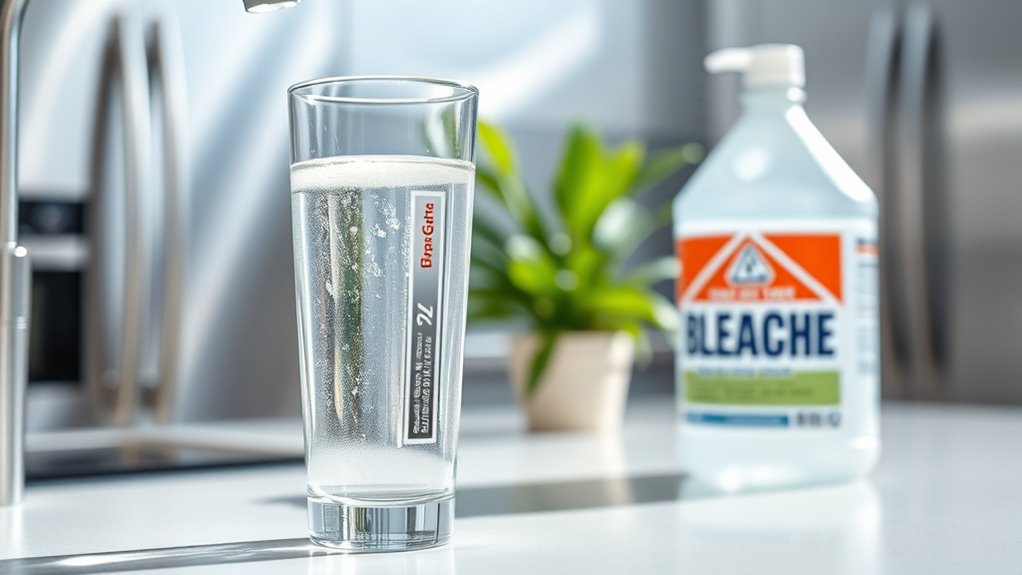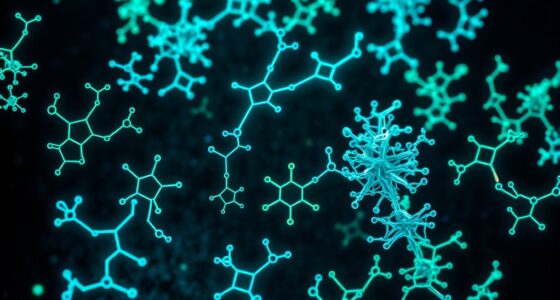Using bleach (containing chlorine) in drinking water acts as an effective disinfectant that kills harmful microbes and keeps your water safe. However, residual chlorine can cause a taste or odor you might not like and may form potentially harmful byproducts over time. Generally, small amounts are safe, but prolonged exposure might pose health risks. To learn more about balancing disinfection and safety, uncover what you need to know next.
Key Takeaways
- Chlorine, used for disinfecting drinking water, effectively kills pathogens but can leave a chemical taste and potential health concerns.
- Small residual amounts of chlorine are generally safe; however, long-term exposure may be linked to health risks like cancer.
- Disinfection byproducts, such as trihalomethanes, form when chlorine reacts with organic matter, raising safety considerations.
- Installing activated carbon filters reduces chlorine taste and chemical exposure without compromising microbial safety.
- Balancing chlorine levels ensures effective disinfection while minimizing health risks and chemical byproduct formation.

Have you ever wondered if the bleach you hear about is present in your drinking water? It’s a common concern, especially since many municipal water supplies use chlorine to disinfect the water you consume daily. While chlorine is effective at killing harmful bacteria and preventing waterborne diseases, it also introduces a chlorine taste that can be off-putting. You might notice a slight chemical flavor in your tap water, which can make you question whether it’s safe to drink.
Many municipal waters contain chlorine, which ensures safety but can cause an unpleasant taste.
That chlorine taste often signals the presence of residual chlorine, a byproduct of the disinfection process. Many people worry about health concerns associated with this chemical, fearing that long-term exposure could pose risks. However, regulatory agencies like the EPA set strict limits on how much chlorine can remain in water to guarantee it’s safe for consumption.
It’s important to understand that the small amount of chlorine in your water is generally considered safe, as it’s used in controlled doses. The primary goal is to kill bacteria, viruses, and other pathogens that could cause serious illness. But concerns about health aren’t unfounded. Some studies suggest that prolonged exposure to chlorinated water might be linked to certain health issues, such as bladder or rectal cancers.
Others worry about the formation of disinfection byproducts—chemicals that form when chlorine reacts with organic matter in water. These byproducts, like trihalomethanes, have been associated with increased health risks when consumed over many years. That’s why many consumers seek alternatives, such as filters or bottled water, to reduce their exposure.
Despite these concerns, the use of chlorine remains a crucial part of public health strategies for water safety. It’s a balancing act—using enough chlorine to keep the water free of dangerous microbes, but not so much that it causes taste issues or health risks.
If you’re sensitive to the chlorine taste, installing a good water filter can help. Activated carbon filters are particularly effective at removing residual chlorine and improving the taste. They also reduce some of the potential health concerns linked to disinfection byproducts.
Still, it’s worth noting that completely eliminating chlorine from tap water isn’t always necessary or advisable, as it could increase the risk of microbial contamination.
In the end, understanding the presence of chlorine in your drinking water helps you make informed choices. While the taste might be unpleasant, the health concerns associated with regulated levels of chlorine are minimal for most people. Maintaining a balance between effective disinfection and minimizing chemical exposure is key.
If you’re worried, consulting local water quality reports and considering home filtration options can give you peace of mind without sacrificing safety.
Frequently Asked Questions
How Does Bleach Affect Infants and Pregnant Women?
You should be cautious because bleach can negatively impact infant health and pregnancy safety. Exposure to bleach fumes or accidental ingestion may cause respiratory issues, skin irritation, or other health problems for infants and pregnant women.
It’s essential to minimize contact and guarantee proper ventilation. If you’re pregnant or caring for an infant, avoid direct exposure and consult a healthcare professional if you suspect any health concerns related to bleach.
Are There Natural Alternatives to Bleach for Water Disinfection?
You can explore natural alternatives for water purification, such as solar disinfection, which uses sunlight to kill germs, or boiling water for at least one minute to guarantee safety.
Other options include using iodine tablets or natural filters like activated charcoal. These methods are effective, eco-friendly, and safer than bleach, especially if you’re concerned about chemical exposure.
Always choose the method best suited to your environment and water quality.
What Are the Long-Term Health Effects of Consuming Chlorinated Water?
Did you know that long-term chlorine exposure in drinking water has been linked to increased risks of bladder and rectal cancers?
Consuming chlorinated water may also lead to respiratory issues and skin irritations. While chlorine improves water safety by killing pathogens, sustained ingestion could have adverse health effects over time.
It’s crucial to stay informed about water quality and consider filtration options to reduce potential risks associated with long-term chlorinated water consumption.
How Can I Test My Tap Water for Bleach Residues?
You can test your tap water for bleach residues using home test kits that include chemical indicators. These kits are simple to use and provide quick results.
Just follow the instructions, add a few drops of the reagent to your water sample, and observe the color change. If the indicator detects bleach, it’ll change color, letting you know if there are residual disinfectants in your water.
Is Boiling Water Effective in Removing Bleach?
Think of boiling water as a fierce warrior battling bleach residues. While it triggers chemical reactions that can break down some compounds, boiling isn’t highly effective at removing bleach entirely.
The heat may reduce odors or some chemicals, but it doesn’t guarantee all bleach is gone. For thorough removal, consider alternative methods like letting water sit or using activated charcoal filters, since boiling alone isn’t a magic fix.
Conclusion
Ultimately, you need to weigh the benefits against the risks. Bleach may keep your water safe from harmful pathogens, but it also poses health hazards if misused. You must stay informed, stay cautious, and stay proactive. Remember, safe water means understanding what’s in it, controlling what’s in it, and trusting what’s best for your health. Make smart choices, stay vigilant, and prioritize your well-being every time you turn on the tap.









